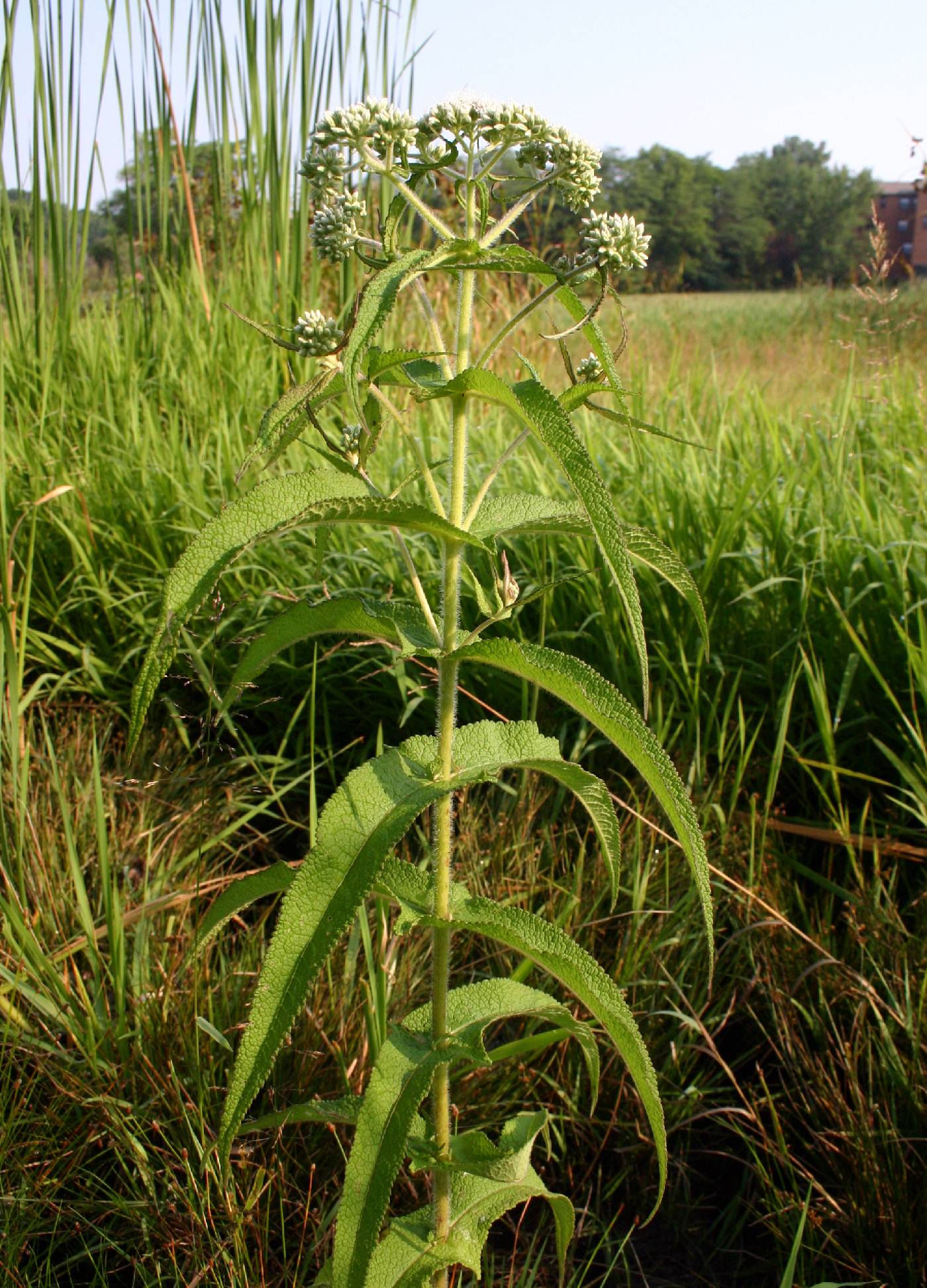
|
Family: Asteraceae |
Perennials, 30-200 cm. Stems erect, usually not branched proximal to arrays of heads (from caudices or rhizomes). Leaves mostly cauline; usually opposite (rarely whorled, distal sometimes alternate); petiolate or sessile; blades usually 3-nerved from or distal to bases, or pinnately nerved, mostly deltate or ovate to lanceolate or linear (and intermediate shapes, sometimes elliptic, oblong, rhombic, or suborbiculate, sometimes pinnatifid, 1-2-pinnately, ternately, or palmately lobed), ultimate margins entire or toothed, faces glabrous or puberulent, pubescent, scabrous, or setulose, usually gland-dotted. Heads discoid, in corymbiform or diffuse to dense, paniculiform arrays. Involucres obconic to ellipsoid, 1-3(-5+) mm diam. Phyllaries persistent, 7-15+ in 2-3(-4+) series, (usually green) 2-3-nerved, or not notably nerved, or pinnately nerved, elliptic, lanceolate, oblong, or obovate, usually unequal, sometimes ± equal (margins scarious, hyaline, apices rounded to acute or acuminate sometimes mucronate, faces usually puberulent or villous, usually gland-dotted, rarely glabrous). Receptacles flat or convex, epaleate. Florets (3-)5(-15+); corollas usually white, rarely pinkish, throats funnelform to campanulate, lobes 5, triangular; styles: bases sometimes enlarged, usually puberulent (glabrous in E. capillifolium), branches mostly filiform. Cypselae (brownish to black) prismatic, 5-ribbed, usually glabrous, usually gland-dotted; pappi persistent, of 20-50 (whitish) barbellulate bristles in 1 series. x = 10. Eupatorium is treated here in a restricted circumscription, following R. M. King and H. Robinson (1987) in excluding genera that traditionally have been included in a broad Eupatorium (e.g., Ageratina, Chromolaena, Critonia, Conoclinium, Fleischmannia, Koanophyllon, Tamaulipa); Eutrochium (Eupatorium sect. Verticillatum) is also excluded here. Species identification within Eupatorium is sometimes complicated; polyploidy and apomixis have contributed to the complications. Some species include both sexual diploid and apomictic polyploid plants or populations. V. I. Sullivan (1972) made important contributions to understanding Eupatorium in North America by showing that some fairly distinct, sexual diploid species may include apomictic polyploid plants or populations that do not differ greatly from the diploids. Other apomictic polyploids appear to be intermediate morphologically between pairs of diploid or diploid/polyploid species and were proposed by Sullivan to have originated from interspecific hybridization. Distinction and level of recognition of hybrid apomictic taxa have a large arbitrary component, in part because some apomicts appear to be ephemeral and others may be relatively stable and in part because differences in the relative genomic contributions of the progenitors through dosage effects or backcrossing may affect whether an apomict is morphologically distinctive or part of a continuous series of variation.
Heads discoid; the fls all tubular and perfect; invol bracts variously imbricate or subequal; receptacle naked; fls pink or purple to blue or white; style-branches elongate, linear or linear-clavate, obtuse, papillate, with inconspicuously ventromarginal stigmatic lines near the base (or sometimes for much of their length); achenes prismatic, mostly 5(-8)-angled and -nerved, glabrous, or inconspicuously hairy along the veins, or in most of our spp. atomiferous-glandular; pappus a single series of capillary bristles; perennial herbs (all ours) or shrubs, with entire or toothed to occasionally dissected, often glandular-punctate, mostly opposite, sometimes whorled or alternate lvs, all our spp. with the lowest lvs reduced and sometimes deciduous; heads small to large, in a mostly corymbiform infl, rarely solitary or forming a true panicle. Nearly 1000, mainly New World. Divided by some authors into numerous much smaller genera, these perhaps better regarded as sections or subgenera. Some of the segregates are indicated in parentheses in the key. In the system of King and Robinson our sp. 6 is referred to Conoclinium, 7 to Fleischmannia, and 8-10 to Ageratina; the others remain in Eupatorium.
Spp. 1-5 form a closely related, hybridizing, mainly diploid group, with x=10. Spp. 8-10 form a closely related group of diploids with x=17. Spp. 11-25 form an intricately reticulate complex of diploids, autopolyploids, established or temporary allopolyploids, and temporary hybrids, based on x=10. The diploids are mainly sexual and outcrossing, the polyploids mainly apomictic.
Some spp. here recognized are wholly diploid; others consist of both diploid and polyploid elements, the polyploids being taxonomically associated with the diploids they most resemble. Only E. godfreyanum, among our spp., appears to be wholly polyploid. In addition to the taxa recognized here, there are scattered small populations representing diverse sorts of allopolyploids that may not be permanently established. It does not seem useful to provide these with formal names. Gleason, Henry A. & Cronquist, Arthur J. 1991. Manual of vascular plants of northeastern United States and adjacent Canada. lxxv + 910 pp. ©The New York Botanical Garden. All rights reserved. Used by permission. |



